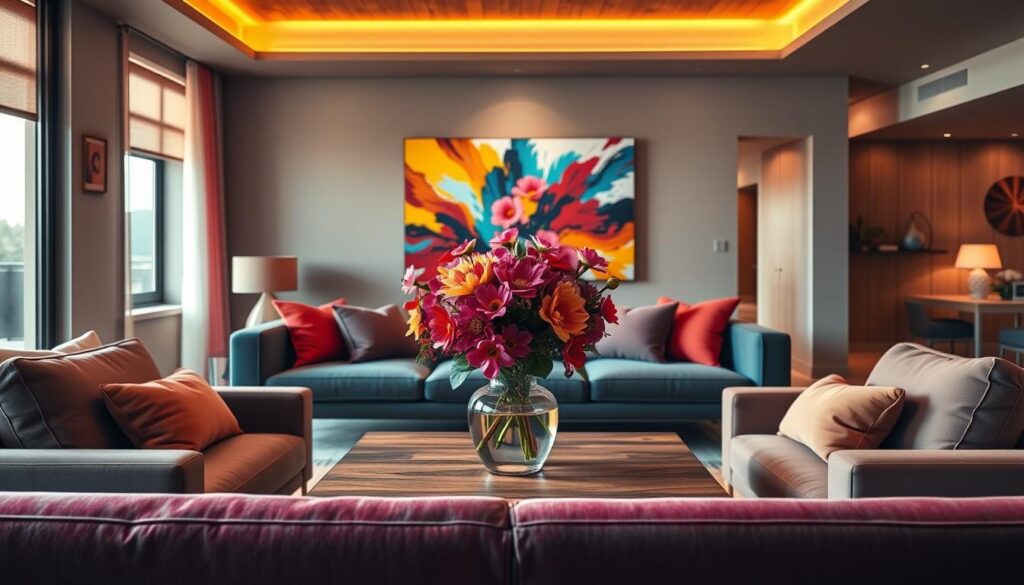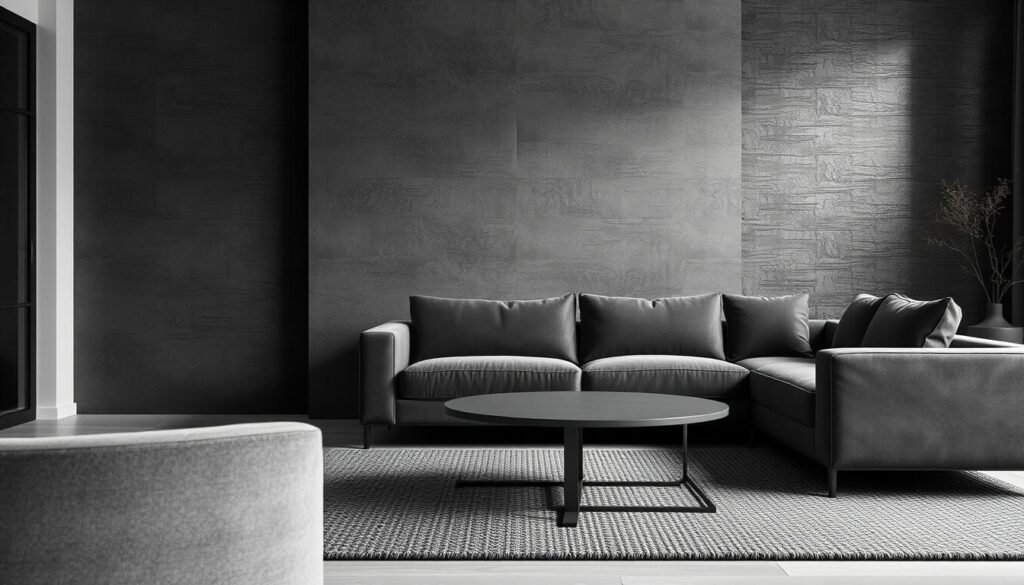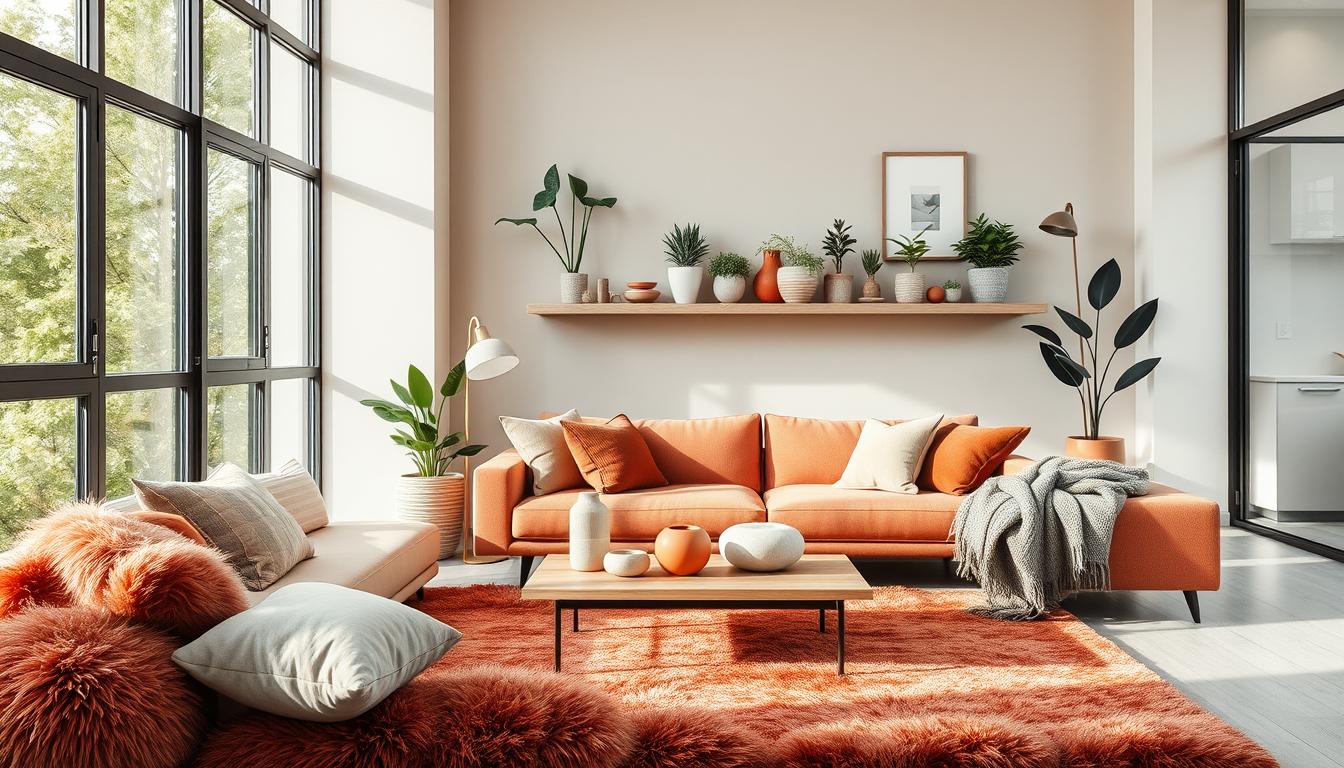Choosing the right colors for your home can feel like a big challenge. With so many options, picking the perfect interior colors can be tough.
In our whole home color palette story, we found that the right shades can change your living space. The colors you pick for your home interiors really affect the feel of your space.
We’ll help you find the best top paint colors for your home interiors. This way, your space will show off your personal style.
Key Takeaways
- Understanding the importance of a cohesive color scheme
- Exploring current trending color palettes for inspiration
- Discovering the best top paint colors for different rooms
- Learning how to balance bold and neutral shades
- Creating a harmonious atmosphere in your home
Introduction to Trending Colors in Home Interiors
Trending color palettes are more than just a short-lived trend. They help turn your home into a mirror of your style. As we look at home interiors today, it’s clear that popular interior design color trends are key in shaping our homes’ looks.
Havenly designer Kelsey Fischer says picking the right colors is vital when starting fresh or updating your decor. “We’ll show you the top palettes to think about,” she notes, highlighting the role of stylish home decor colors in achieving a unified look.
Choosing trending color palettes means thinking about the mood you want in your home. Whether you prefer bold colors or soft ones, finding a balance is key. It should show your personality and match your space.
As we dive into popular interior design color trends, we’ll look at the most stylish and wanted color schemes. We’ll cover everything from classic neutrals to bold colors. This will help you find a look that’s both trendy and uniquely yours.
The Psychology of Color in Home Design
Choosing colors for our homes can greatly affect our mood and experience. At Havenly, we pick a color palette first. We know colors set the mood of a space.
Colors can change how we feel and act. Some colors are better for certain rooms. For example, blues and greens calm us, making them great for bedrooms. On the other hand, oranges and yellows boost energy, perfect for kitchens and dining areas.
How Colors Influence Mood
Colors deeply affect our mood and feelings. Warm colors like reds, oranges, and yellows energize us. Cool colors like blues, greens, and purples calm us. Knowing this helps pick the right colors for each room.
- Reds and oranges boost heart rate and spark conversation, ideal for social spots.
- Blues and greens calm us, great for bedrooms and bathrooms.
- Yellows uplift and inspire, often used in kitchens and home offices.
Selecting Colors Based on Room Function
Different rooms have different uses, and colors should match. For example, a home office might need colors that help focus, like greens or blues. A living room, on the other hand, should use colors that promote relaxation and togetherness.
- For bedrooms, soft, calming colors like light blues or mauves work well.
- Living rooms can use warm neutrals or rich jewel tones for a cozy feel.
- Kitchens and dining areas can be brightened with red or orange, but balance with neutrals to avoid too much.
By choosing colors wisely for each room, we can make spaces that are not just beautiful but also emotionally supportive.
Popular Neutral Shades for 2023
Neutral shades are still popular in 2023, offering a calm and versatile look for our homes. These colors provide a clean background for decorating and add sophistication.
Warm grays and beiges are big this year. They add warmth and coziness to rooms, making them great for living areas and bedrooms.
Warm Grays and Beiges
Warm grays and beiges are versatile and soothing. They work well with many decorating styles, from modern to traditional. For example, a warm beige can make a room cozy, while a soft gray can contrast nicely with bold furniture.
Looking to add these shades to your home? Check out the neutral paint colors at Sherwin-Williams. They have a range of warm grays and beiges to enhance any space.
Classic Whites and Creams
Classic whites and creams are key in neutral design, giving rooms a clean and airy feel. They’re great in small spaces, making them seem larger. Plus, they’re perfect for showing off colorful furniture and decor without being too much.
When picking between whites and creams, think about your room’s natural light. Ample natural light makes these shades brighter and more lively, improving your space’s feel.
Vibrant Accent Colors to Consider
Accent colors can really change a room’s feel. Choosing vibrant colors can make a big difference. These colors can brighten up furniture, rugs, and decorations, making a room feel welcoming.
Jewel Tones for Boldness
Jewel tones bring a bold and luxurious vibe. Colors like emerald green, sapphire blue, and ruby red add sophistication. Use them in vases, throw pillows, or a bold wall to make a statement.

Pastels for a Soft Touch
Pastel colors bring a soft, calming feel. Shades like blush pink, mint green, and powder blue make spaces peaceful. Use them in bedding, curtains, or accessories for elegance.
When using vibrant colors, balance them with neutral tones. This avoids overwhelming the space. Find the right mix that shows off your style.
Earthy Tones: Connecting with Nature
Earthy tones are key in bringing nature indoors. They include greens, browns, terracottas, and clays. These colors create a calm and welcoming space in any home.
These hues add warmth and balance to our homes. They help create a look that feels both solid and stylish.
Greens and Browns for Serenity
Greens and browns are central to earthy tones. They offer shades that remind us of forests or natural wood. Deep olive greens and earthy browns make a bold yet balanced look, like a dense forest.
Together, they create a calming atmosphere. It’s great for living rooms, bedrooms, or any place you want to relax.
Terracotta and Clay Inspirations
Terracotta and clay tones bring warmth to interiors. They can be used as accents or as the main color in a room. Terracotta is perfect in kitchens and dining areas, adding a rustic charm.
By mixing terracotta and clay with other earthy tones, you get a rich, natural look. It feels connected to the outdoors.
Monochrome Schemes: The Timeless Look
Monochrome schemes are loved for their ability to make spaces look harmonious and beautiful. Using one color throughout the home creates a unified look. This look is elegant and sophisticated.
One big plus of monochrome schemes is how they tie everything together. A single color palette can unify different spaces. This makes the design feel more cohesive and streamlined.
Benefits of a Single Color Palette
Choosing one color for your home has many benefits. These include:
- Creating a calm and serene atmosphere
- Improving the home’s aesthetic appeal
- Making design easier by cutting down on color choices
Design experts say, “With 144 colors expertly formulated to mix and match, Affinity creates harmonious color flow from room-to-room.” This method removes the guesswork, ensuring a unified look across the home.
“A well-designed monochrome scheme can make a space feel larger and more connected.”
How to Add Depth with Texture
Even with a single color, adding texture is key to depth and interest. Mixing different textures can make a room more visually appealing. It prevents it from feeling flat or dull.
Here are some ways to add texture:
- Use a variety of fabrics, like velvet, linen, and cotton
- Choose different materials for furniture, such as wood, metal, and glass
- Add decorative items, like woven baskets and throw blankets

By mixing a single color with various textures, you can create a stylish and welcoming space. This space will feel both modern and timeless.
Coastal-Inspired Color Palettes
Coastal color palettes bring a fresh vibe to our homes. They mimic the ocean’s calm and the beach’s softness. This makes our living spaces feel like peaceful retreats.
This style is called warm minimalism. It’s all about layers and textures. Neutrals like taupe, ivory, and beige create a cozy feel. They blend the coast’s beauty with our home’s comfort.
Soft Blues and Sandy Beiges
Soft blues and sandy beiges are key in coastal color schemes. They remind us of calm seas and soft beaches. Pairing them in your home brings a soothing feel.
Refreshing Teal and Coral Accents
For a bold look, add teal and coral accents. Teal is like tropical waters, and coral is inspired by sea life. Together, they make a lively yet balanced palette. Use teal for walls or furniture, and coral for accessories to add color and energy.
Choosing coastal colors thoughtfully can make our homes welcoming. Whether you like soft blues and beiges or teal and coral, there’s a palette for everyone.
The Return of Bold Dark Colors
Bold dark colors are back in style, adding drama and mood to homes. They’re not just for making a bold statement. They also make spaces feel luxurious and cozy.
Using bold dark colors brings sophistication to your home. Deep navy and charcoal are favorites because they’re great as background colors. They pair well with many other colors.
Deep Navy and Charcoal as Statement Shades
Deep navy and charcoal are more than dark colors. They’re statement pieces that can make any room look better. These colors fit many design styles, from modern to traditional. They’re perfect for walls, furniture, or as accent colors.
| Color | Best Used For | Complementary Colors |
|---|---|---|
| Deep Navy | Accent walls, furniture | Gold, cream, light wood |
| Charcoal | Walls, cabinets, trim | Soft pastels, metallic accents |
Tips for Balancing Dark Colors in Spaces
While bold dark colors add depth and character, it’s key to balance them. Here are some tips:
- Pair dark colors with lighter shades to create contrast.
- Use dark colors on a single accent wall to create a focal point.
- Balance dark furniture with lighter flooring and curtains.
By carefully using bold dark colors like deep navy and charcoal, you can create a timeless look. This approach lets you enjoy both the moodiness and the elegance in your home design.
Color Combinations for Specific Rooms
The right colors can make your home feel cozy and functional. It’s important to think about each room’s needs and mood. This helps pick the best color schemes.
Cozy Living Room Palettes
The living room is where families and friends come together. For a cozy living room, choose warm colors. Beige, soft grays, and creamy whites are great for a calm feel. Adding deep accent colors like burgundy or navy blue makes it cozier.
For a modern look, try earthy tones like terracotta or sienna. They add warmth without being too much. Designer Kelly Wearstler says, “Color is a powerful tool, and it can completely change the feeling of a room.”
“Color is a powerful tool, and it can completely change the feeling of a room.” – Kelly Wearstler
Inviting Kitchen and Dining Room Ideas
Kitchens and dining areas are where memories are made. Inviting color schemes can make you hungry and encourage talking. Soft yellows, warm reds, and rich wood tones are great for a welcoming feel.
- Soft yellows brighten the space and add energy.
- Warm reds make you hungry and cozy.
- Rich wood tones bring natural warmth and style.
Calming Bedroom Color Choices
Bedrooms should be peaceful places. Calming bedroom colors like soft pastels, gentle blues, and muted greens are perfect. For a relaxing guest room or kids’ room, soft pastels are best. Think of pastel green, yellow, gray, or dusty lavender for a calm feel.
To add depth without disturbing the calm, use different textures and subtle patterns. Interior design experts say layering elements can make it interesting without being too much.
Trends in Sustainable Paint Options
Sustainable paint options are gaining popularity. Homeowners want choices that are good for the planet. This shift is due to growing awareness of traditional paint’s environmental impact.
Eco-friendly paints are stylish and durable. They benefit the planet and offer a range of finishes. Our experts have created color palettes that are both beautiful and eco-friendly for your home.
Eco-Friendly Colors for the Conscious Home
Eco-friendly colors are now vibrant and stylish. They’re made from natural ingredients. These colors are good for the environment and add a unique touch to your decor.
Popular eco-friendly paint brands offer low-VOC options. These paints improve indoor air quality. You can choose paints made from clay, plant dyes, or recycled materials. They reduce environmental impact and create a healthier home.
Low-VOC Paints That Offer Style
Low-VOC paints have improved in quality and style. They come in various finishes, from matte to high gloss. You can achieve many looks, from modern to traditional.
When picking low-VOC paints, think about your home’s look. You can go for a monochromatic scheme or contrasting colors. Our experts suggest trying different textures and finishes for depth.
Low-VOC paints have many benefits:
- Improved indoor air quality
- Reduced environmental impact
- A wide range of color options
- Durable and long-lasting finishes
Choosing sustainable paint options beautifies your home and helps the environment. We encourage you to explore these eco-friendly choices for your next home decor project.
Conclusion: Choosing the Right Palette for You
Choosing the perfect color palette for your home can seem hard. But, with the right help, it can be very rewarding. We’ve looked at many colors and methods to guide you.
Tailoring Your Color Scheme
When picking personalized color selection, think about the mood you want in your room. Warm colors like orange, yellow, and red make a space cozy. Cool colors like blue, green, and purple are calming.
The 60/30/10 interior decorating rule helps balance your colors.
Finding Inspiration
For resources for inspiration, check out nature, interior design blogs, or get advice from a pro. If you need help with your space, try a style quiz. It can connect you with a design expert for personalized advice.
This way, you can find the best popular home interior colors for your home.
Think about what you like and how each room will be used. This helps create a space that’s both lovely and useful. Picking the right colors is key. With these tips, you’re on your way to a home that shows off your style.


